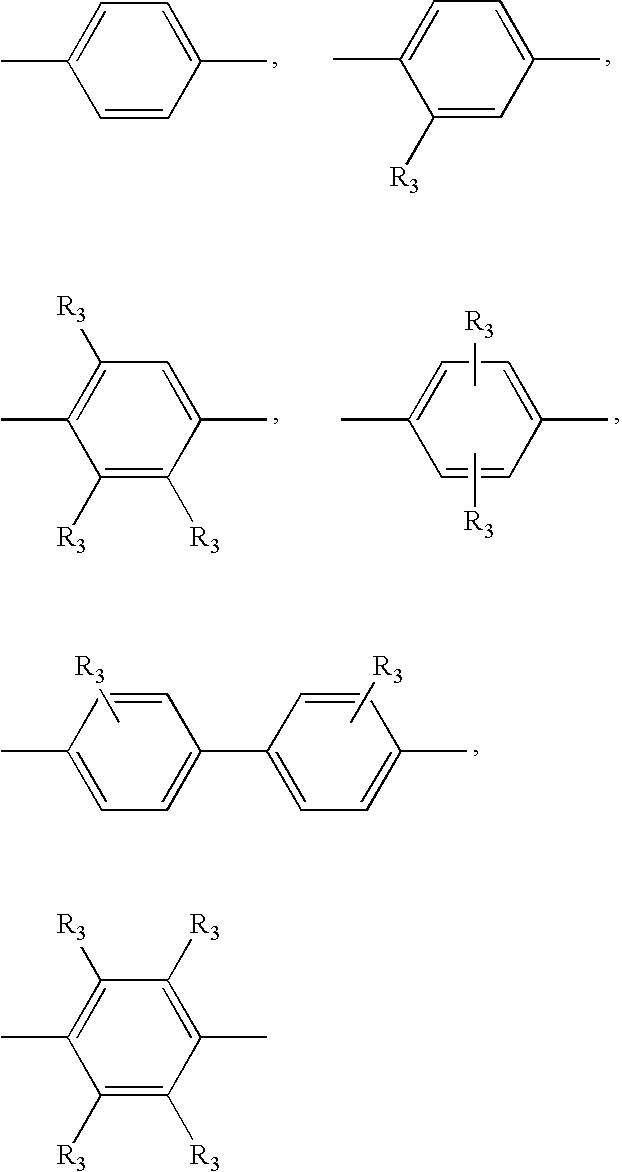Novel Polyimide Film and Use Thereof
a polyimide film and polyimide technology, applied in the field of polyimide film, can solve the problems of reducing the cost of the device method for the laminate method than the metallization method, shifting the components, and the assumption that the thermal adhesive will soon have a difficulty in meeting the increasing demand for fpc, so as to reduce the thermal stress of the lamination and securely suppress the dimensional change
- Summary
- Abstract
- Description
- Claims
- Application Information
AI Technical Summary
Benefits of technology
Problems solved by technology
Method used
Image
Examples
synthesis example 1
Synthesis of Thermoplastic Polyimide Precursor
[0247]780 g of N,N-dimethylformamide (also referred to as “DMF”, hereinafter) and 115.6 g of BAPP was fed into a 2000-ml glass flask. Then, 78.7 g of a 3,3′,4,4′-biphenyltetracarboxylic acid dianhydride (also referred to as “BPDA”, hereinafter) was fed by degrees into the mixture while the mixture was stirred under nitrogen atmosphere. Then, 3.8 g of a 3,3′,4,4′-ethyleneglycol dibenzoate tetracarboxylic acid dianhydride (also referred to as “TMEG”, hereinafter) was added to the mixture, and stirred for 30 minutes on ice bath. Aside from this, a solution in which 2.0 g of TMEG was dissolved to 20 g of DMF was prepared, and added by degrees to the foregoing reaction solution. With the addition of the solution, the solution was stirred while watching for the viscosity. The addition / stirring was stopped when the viscosity became 3000 poise (300 Pa·s). A polyamic acid solution was thus prepared.
[0248]The produced polyamic acid solution was ca...
examples 1 to 4
Synthesis of Polyimide Film
[0249]4,4′-diaminodiphenylether (also referred to as “4,4′-ODA”, hereinafter) and BAPP were added to DMF at mole ratios shown in Table 1 in a reaction system kept at 5° C., and stirred. After visually confirming the dissolution, s 3,3′,4,4′-benzophenone tetracarboxylic acid dianhydride (also referred to as “BTDA”, hereinafter), and stirred for 30 minutes.
TABLE 1PMDAPMDA4,4′-ODABAPPBTDA(First)p-PDA(Second)Example 1203025205052Example 2203030155052Example 3104020255052Example 4104025205052
[0250]Next, a pyromellitic acid dianhydride (also referred to as “PMDA”, hereinafter) was added at a mole ratio shown in “PMDA (First)” of Table 1, stirred for 30 minutes, so as to form thermoplastic polyimide precursor block component. Then, p-phenylenediamine (also referred to as “p-PDA”, hereinafter) was added at a mole ratio shown in Table 1. After dissolving the p-phenylenediamine, PMDA was added again at a mole ratio shown in “PMDA (Second)” of Table 1, and stirred fo...
examples 5 to 8
Production of Polyimide Film
[0255]An imidization accelerator agent containing acetic acid anhydride / isoquinoline / DMF (weight ratio 2.0 / 0.3 / 4.0) was added to the polyamic acid solution produced by the same method used in Examples 1 to 4 at a weight ratio of 45%. The resulting solution was stirred continuously by a mixer, and extruded from a T-die to be casted onto a stainless endless belt running 20 mm below the die. After heating this resin film at 130° C.×100 seconds, the self-supporting gel film was peeled off the endless belt (content of volatile component=30 weight %) and fixed to a tenterclip, and dried and imidized at 300° C. for 22 seconds, at 400° C. for 22 seconds, at 500° C. for 22 seconds. A 10-μm thick polyimide film was thus obtained.
PUM
| Property | Measurement | Unit |
|---|---|---|
| mol % | aaaaa | aaaaa |
| mol % | aaaaa | aaaaa |
| Tg | aaaaa | aaaaa |
Abstract
Description
Claims
Application Information
 Login to View More
Login to View More - R&D
- Intellectual Property
- Life Sciences
- Materials
- Tech Scout
- Unparalleled Data Quality
- Higher Quality Content
- 60% Fewer Hallucinations
Browse by: Latest US Patents, China's latest patents, Technical Efficacy Thesaurus, Application Domain, Technology Topic, Popular Technical Reports.
© 2025 PatSnap. All rights reserved.Legal|Privacy policy|Modern Slavery Act Transparency Statement|Sitemap|About US| Contact US: help@patsnap.com



